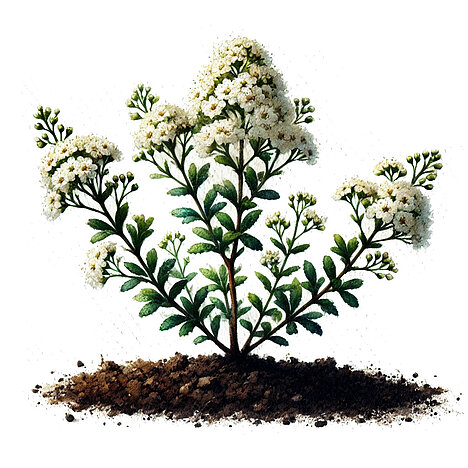Spirea bushes

Spirea shrubs, also known as spiraea, adorn many gardens with their lush blooms. These low-maintenance and undemanding ornamental shrubs are available in numerous varieties that bloom from early spring to late fall. But while they are a feast for the eyes for humans, dog owners often ask themselves: Are spirea bushes safe for my four-legged friends? In this article, we shed light on what spirea shrubs are exactly and discuss their advantages and disadvantages in relation to dogs.
What are spirea shrubs?
Spirea shrubs belong to the rose family (Rosaceae) and include over 80 species, which are mainly native to Asia, North America and Europe. They are characterized by their diverse flower colors in white, pink, red or yellow and their different growth heights. Spirea shrubs are popular because of their ease of care, their tolerance to pruning and their ability to attract butterflies and other beneficial insects.
Advantages of spirea shrubs in the garden
Aesthetic value
With their abundant flowers and varying growth heights, spirea shrubs can contribute to the design of diverse garden landscapes. They are ideal for flowering hedges, as specimen plants or in mixed borders.
Attracting beneficial insects
Spirea shrubs attract numerous beneficial insects with their flowers, including butterflies and pollinators, which contribute to the health of the garden.
Easy to care for
Because they are undemanding and tolerate pruning, spireas are ideal for garden owners who appreciate low maintenance.
Disadvantages of spirea shrubs in relation to dogs
Potential toxicity
Although spirea is not considered highly toxic to dogs, in rare cases it can cause gastrointestinal discomfort if eaten. Symptoms of mild poisoning may include vomiting, diarrhea and lethargy.
Risk of injury
Some species of spirea can have sharp branches that can cause injury to dogs, especially when they are romping around. It's important to know the type of spirea in your garden and make areas with sharp branches inaccessible to your dog.
Allergies
Although rare, some dogs can develop allergic reactions to pollen or components of the plant. Symptoms of an allergy can include skin irritation, sneezing and eye irritation.
Spirea shrubs can be a beautiful and low-maintenance addition to your garden, as well as providing a habitat for beneficial insects. Most species are safe for dogs, but care should be taken and plants should be positioned to avoid accidental ingestion or injury. Watch your dog while playing in the garden and look out for signs of allergic reaction or poisoning.
If you notice any signs of hypersensitivity or poisoning in your dog, you should see your vet immediately. We are not a substitute for a vet, but we try to be as accurate as possible. Every dog reacts differently and we recommend you get a second opinion or consult your vet if in doubt.
Stay healthy and take good care of your four-legged friend!😊